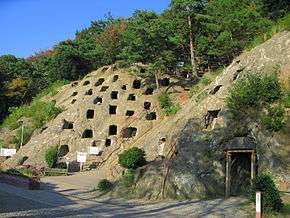Yoshimi Hundred Caves
| 吉見百穴 | |
 Yoshimi Hundred Caves | |
| Alternate name |
|
|---|---|
| Region | JP |
| Coordinates | 36°02′21″N 139°25′18″E / 36.03917°N 139.42167°ECoordinates: 36°02′21″N 139°25′18″E / 36.03917°N 139.42167°E |
| Type | landmark |
| History | |
| Founded | 6th-7th century CE |
| Periods | Kofun |
| Site notes | |
| Ownership | Public |
| Public access | Yes |
| Website |
www |
Yoshimi Hundred Caves (吉見百穴 Yoshimi Hyakketsu) is a cluster of Kofun period graves dug in artificial caves in a tuff cliff of located in Yoshimi, Saitama, in the northern Kantō region of Japan. It was designated as a National Historic Site on March 7, 1923.[1] The Schistostega moss growing at the site was also designated as a Natural Monument of Japan on November 30, 1928.[2]
Background
The cliff is located on the Yoshimi Hills (吉見丘陵 Yoshimi Kyūryō), which connects to the Hiki Hills (比企丘陵 Hiki Kyūryō) to the north.[3] The burial caves, which actually number 216 and not one hundred, each have an opening approximately one meter square, with a narrow entrance tunnel leading to a larger chamber within, extending several meters into the hill. The graves extend in several rows running west to east along the face of the hill, with the entrances varying slightly in size due to the topography. Most have an elevated structure within the internal chamber, which may have originally held coffins or the bodies of those interred, and some chambers have multiple pedestals, indicating that the burial chamber were used for multiple burials. The entrances to the caves appear to have formerly been blocked by schist slabs.
History
The caves were first excavated in 1887 by Tsuboi Shōgorō, a professor at Tokyo Imperial University and one of the pioneers of Japanese archaeology and anthropology. Tsuboi found Jōmon period pottery fragments at the site as well, and postulated that the caves were originally dwellings for a race of people smaller than the modern Japanese, possibly the Koro-pok-guru people of Ainu legend, and were later converted into tombs by the invading Yamato peoples. However, his theory was challenged after further research in the 1920s, notably by Mitsutarō Shirai and other archaeologists, who argued that the structure of the caves and artifacts recovered were consistent with other late Kofun period tombs, and that there was no material evidence to indicate that the Koro-pok-guru were anything more than a folktale. As the largest grave cluster in Japan and was designated as a National Historic Monument on March 7, 1923.
Despite the protected status, about one tenth of the site was destroyed during the final days of World War II, when some of the caves were enlarged in order to create an underground aircraft engine factory for Nakajima Aircraft Company by some 3000-3500 Korean forced laborers. The war ended before the factory came into operation.
The site is partially open to the public and contains two museums. One is the Yoshimi Town Archaeological Museum, which displays some of the artifacts discovered as well as other items from the surrounding area. The other is a local history museum with a diorama of Sengoku period Matsuyama Castle, which formerly existed on the summit of a nearby hill.